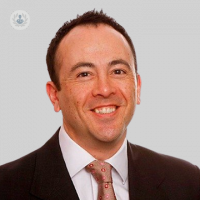Laser eye surgery: what are my options?
Written by:When it comes to laser eye surgery, some people may feel confused by their options. As with all eye treatments, the reasons for choosing one surgery over another will change from person to person. The only way to know which one is best for you is to get an expert opinion.
We’ve asked leading ophthalmologist Mr David Anderson to explain the differences between the major types of laser eye surgery that are available, from LASIK, LASEK, PRK to SMILE. Here’s his simple guide on the surgery types and how they work.

What are the different types of laser surgeries?
The following are the different types of laser surgeries that are used:
PRK (Photorefractive keratectomy)
PRK works by removing the surface layer of the cornea (the epithelium) in order to shape the underlying tissue. The epithelium protects the eye from dust and pollutants. It is the top layer of cells on the cornea that continually regenerates itself. In PRK surgery, the surgeon places a tiny well on the surface of the eye. A few drops of alcohol dissolve the epithelium, knowing that the cornea will grow a new one within a few days. A laser then reshapes the newly-exposed layer of the cornea to correct the vision problem.
PRK is particularly useful for people with thin corneas and certain medical conditions. People who are at risk of eye injuries, such as boxers, rugby players and soldiers, often prefer the procedure as it eliminates the risk of future ‘flap’ complications. It can also be used for patients with thin corneas. Recovery can take a week or more.
LASEK (also known as ASA)
ASA stands for advanced surface ablation. The procedure corrects vision in the same way as PRK. Surgery takes place on the corneal surface and an advanced laser re-sculpts the tissue. In LASEK, however, we do not remove the epithelium during the procedure. We create a small ‘flap’ in those cells, which is gently lifted for a few seconds whilst the laser works on the underlying cornea. The flap is then put back in place and supplemented by a soft contact lens.
LASEK can fix visual problems such as near-sightedness, long-sightedness and astigmatism. It’s an excellent option for people with thin corneas or with a great risk of injuries from high-impact sports. Normal vision returns within two days to a week.
LASIK
LASIK stands for laser-assisted in-situ keratomileusis. The difference in this surgical procedure is how we create the pre-surgery flap. An exceptionally precise femtosecond Visumax laser forms the flap by creating a plane of micro-bubbles, about 100 microns below the surface. Once this tiny section has been peeled back, a second laser is used to correct the vision impairment. Many patients are able to return to work within 24 hours and have 20-20 vision within a few days, which is a real wow factor of the procedure.
LASIK suits most people – short-sighted, long-sighted and patients with astigmatism. Most people with ‘normal’ eyes tend to choose this procedure as the recovery is fast and comfortable. It is unsuitable for people with thin corneas or who suffer from dry eyes.
SMILE
SMILE is becoming one of the most popular treatments available. SMILE stands for small incision lenticule extraction although some people refer to it as keyhole LASIK. It works by using a femtosecond laser to create what is known as a lenticule, or small disk, in the cornea. The lenticule is then removed from a 2-3 mm gap in the surface, which changes the shape of the cornea and corrects the visual impairment.
As a ‘flapless’ procedure, it is more suitable for patients with dry eyes and other ocular-surface problems. The essential stability of the cornea is also maintained since SMILE preserves the front 100 microns of tissue during treatment. SMILE results in a speedy and comfortable recovery although vision may initially be blurry for slightly longer than in LASIK.
If you are considering laser eye treatment, do not hesitate to book an appointment with Mr Anderson who is based at the Anderson Eye Care Centre to discuss your options.


